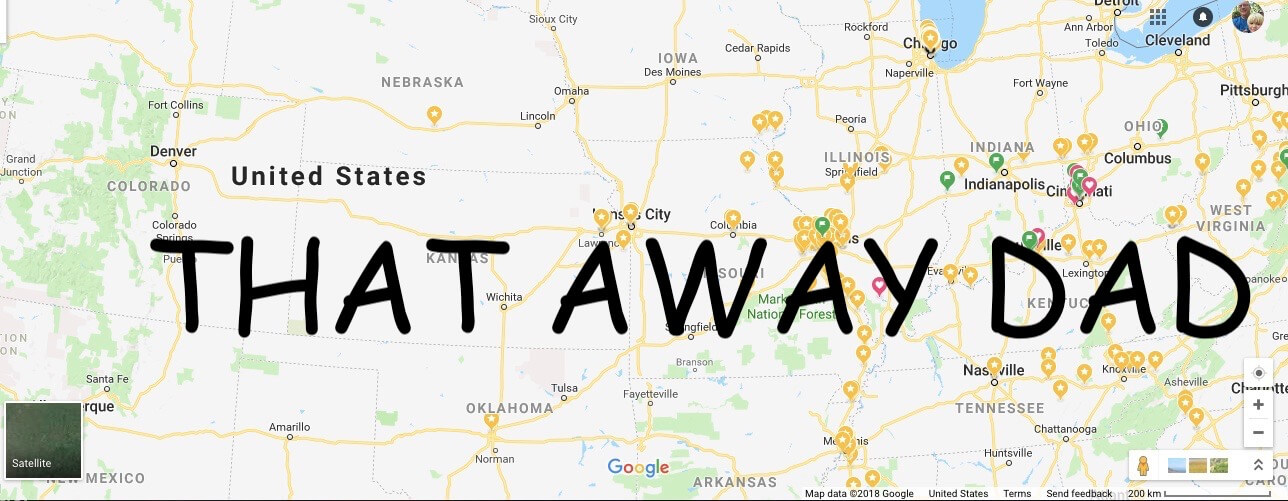The largest area of Native American Rock art in Illinois is found at Piney Creek Ravine Nature Preserve.
This 198-acre nature preserve also has cascading waterfalls and colorful limestone cliffs.
Our Hike

Starting the Hike
It was a whole family trip including the dog. The two-mile loop trail begins between two farm fields from the gravel parking lot.
Next, we came to a second sign where the trail goes to the right and left to make the loop.
We headed to the right and began the walk through the woods.

After crossing a long wooden bridge we came to a small brook cascading down through stony terrain.

We walked by large boulders along our path.

Rock Art Side Trail
Then we came to a side trail that you can reach from both sides of the loop. Marked with a narrow green sign, it leads to carved and painted art done by Native Americans.

Rock walls along the trail are colored red, yellow, and orange with Native American markings.

After crossing Piney Creek with its rock overhangs and pools of water we headed to the bluff with the main art.
The carved stone and ancient paintings are worth taking time to admire.

Learning About the Rock Art
I read off a sign with information about the carvings and paintings here and I pointed out what we could see for my son.

What Are the Images?
The images include deer, birds, serpents, crosses, meandering lines, and human-like (anthropomorphic) figures.
Some of the figures have wings, others appear to have horns or horned headdresses.
Still, others hold objects including spears, bows, arrows, and shields.
Horns and weapons can represent spiritual power in Native American art.
The legless winged petroglyphs here are a stylized representation of a Mississippian Period image that appears on shell and copper objects throughout the southeastern United States.
Many Native Americans believed that whoever carved or painted an image of such a dangerous being could acquire its power for personal use.

Why It Is Here?
Some rock sites were sacred locations where Native Americans depicted images seen in religious visions or trances.
Others served as boundary markers between groups or to convey information about an important event.

What Do They Represent?
Although called “rock art,” the painted and carved images found here were not created mainly for art.
It is difficult to interpret what individual rock art images represent. Do the images of the deer in the shelter represent actual animals or they depict spirit beings?
When Were the Images Made?
Most images in the shelter are from the Late Woodland (AD 450-900) and Mississippian periods (AD 900-1500).

My Son Looking for Images
“I see a hunter and a deer,” Andrew said.
“Some of this art was made over a thousand years ago,” I told him.

He kept looking for other figures and found more deer.

Art Damaged in the 1800s
“Dad, there are names carved over some of the art,” Andrew said.
“Yeah, it is sad that people did this,” I said.
I read later that during the late 18th century and early 20th centuries, this area was a popular site for picnics and Sunday school outings. Visitors carved or painted their names directly over the prehistoric rock art, damaging or destroying many images.

Snack Stop Along the Way
We headed back up the way we came.
“I’m hungry,” Andrew said.
“Up ahead along the trail there is a rock face on the creek that we can sit and have a snack,” David said. We had been here years ago.
Andrew agreed and we trudged through more woods to it.

Checking Out the Creek
We wandered the area following the rock features that the creek has shaped.

Water creates channels in the stone.

Small waterfalls flow down to big pools.

I like how the water snakes itself through narrow slits in the hard rock.
Walking Back to the Trailhead
After a bit, we headed along the loop towards the trailhead.
Stopping along the way checking out the sandy and pocket-filled hard surface of the creek as we went.

Final Thoughts
This two-mile hike has a good mix of rocky terrain along with ancient rock art. I look forward to coming back here again to explore the creek and look for art that I might have missed. This is a worthy hike about an hour and forty minutes from St. Louis.

DETAILS:
The Drive
Take Interstate 64 out of St. Louis to exit 23 for Illinois Highway 4, following signs for this highway going south to Campbell Hill, Illinois. In Campbell Hill turn onto Main Street that becomes Rock Crusher Road. Go west on Rock Crusher and look for Piney Creek Road on your right. Take this road just after it turns to gravel looking for the preserve’s parking lot again on your right.
Hours: Sunrise to Sunset
Admission: Free
Address: Piney Creek Rd, Ava, IL 62907
More Native American Sites

Dad Hikes: Prehistoric Graham Cave State Park
Graham Cave State Park is right off Interstate 70 and is a walk into ancient history. Hiking through the park you follow the footsteps of hunters-gathers thousands of years ago who found shelter in Graham Cave.
More Illinois Hikes

Dad Hikes: Illinois Mississippi River Bluffs
My journey today was to explore two trails along the bluffs on the Illinois side of the Mississippi River just south of St. Louis.
Dad Hikes: Horseshoe Lake State Park
Walking among the green stalks of a cornfield and admiring the lakeside flowers were part of our adventure on Walker’s Island at Horseshoe Lake State Park.
Dad Hikes: Olin Nature Preserve
A bubbly waterfall and a monument to the Underground Railroad were found on the trails at the Olin Nature Preserve.


